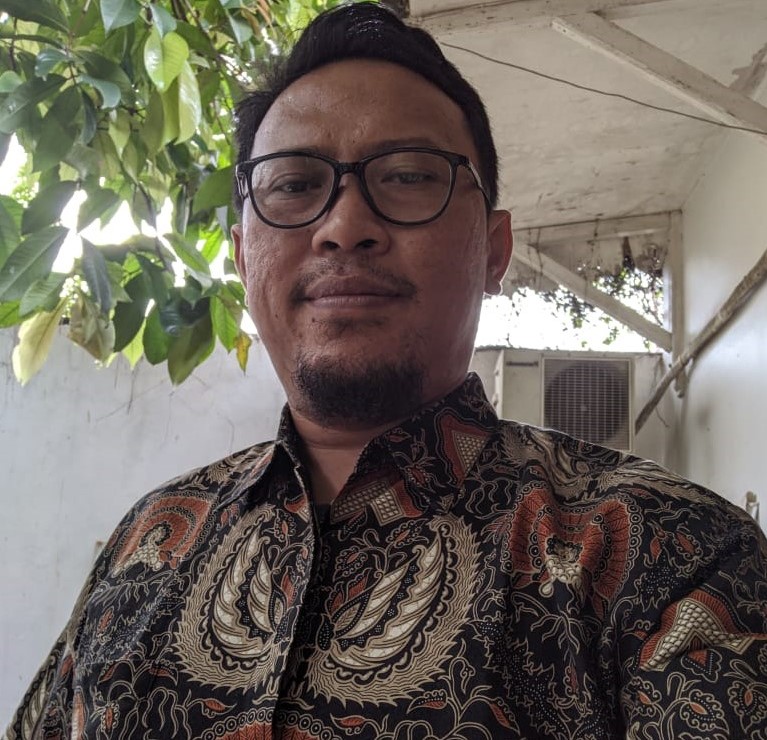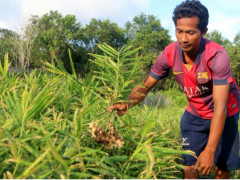Promising Peat Ginger Profits during the Pandemic
By Aries MunandarFood Estate: Reopening the Peatland due to the Pandemic

Central Kalimantan is now under the central government’s spotlight, especially concerning the plan to prepare rice fields for the food estate. This plan was launched after a warning from the Food and Agriculture Organization (FAO) in March 2020. Although the government has previously stated that Indonesia has a surplus of food.
The development of food estates is inversely proportional with the statements often issued by the central government before the Corona (COVID-19) pandemic hit Indonesia. In December 2019, long before the warning was issued by FAO, Syahrul Yasin Limpo, Minister of Agriculture, stated that the national food supply is sufficient until March 2020. He stated that there is 4 million tons of overstock.
Amidst the COVID-19 pandemic, the government used the food crisis issue as an excuse to accelerate the food estate project in Central Kalimantan, an area that was previously used for the one million-hectare Peatland Project (PLG), which became a milestone for irreversible peat damage and environmental disaster. One of the disasters is the peatland forest fires that have been occurring in the last two decades.
The food estate development plan which was suddenly issued by President Jokowi was greatly discussed by a number of parties. Civil society groups even announced their stance, which was supported by 163 organizations and individuals.
The civil society’s rejection has a strong basis, in addition to harming the state finances and damaging the ecosystems, the land ownership gap became more severe and the number of land-related conflicts in this region continues to increase. This is due to the government's policy of issuing oil palm plantations permits for former PLG areas. The government did not enforce the spatial regulations and other policies, because they have issued permits for lands located in the forest areas and lands with a peat protection function.
This has increased the number of land-related conflicts and it robbed the indigenous peoples of their lands and destroyed traditional agricultural systems, such as handil, tatah, as well as tabat and traditional fisheries methods like Beje. It also destroys customary and local wisdom-based farming and land cultivation systems that were developed by indigenous peoples. Transmigration has also changed the social structure and land ownership model in several areas, triggering land-related conflicts due to land titles and customary lands ownership in this region.
Instead of heeding criticism and taking lessons from the PLG failure in 1998, the government has gone ahead with the food estate project and include it as one of the National Strategic Projects. In fact, there has no study has shown that the food estate development in the location will not repeat the same failure.
Despite receiving criticism from various parties, the Food Estate development in Central Kalimantan continues. Basuki Hadimuljono, Ministry of Public Works and Housing, stated that the key to the Central Kalimantan Province food estate development program is the water supply for the irrigation of rice fields, especially on 165,000 hectares of potential land in the alluvial area, not peat area, which was formerly part of the Peatland Development (PLG) land. Of the 165,000 hectares of potential land, 85,500 hectares is functional land that has been annually used for production. On the other hand, the remaining 79,500 hectares are still overgrown by shrubs and only require land clearance, without the preparation of new rice fields. To increase irrigation, an estimated budget of Rp 2.9 trillion is required for 2021 and 2022. According to the Minister of Agriculture, the new food estate in Kapuas District is planned on 20,704 hectares of potential land area. Out of this, 5,840 hectares of the land is functional. On the other hand, the area in Pulang Pisau District that is going to be used for the rice fields is 27,133 hectares and 12,255 hectares have been developed. This is different from the Ministry of Public Works and Housing’s statement.
Through press release number: SP.301./HUMAS/PP/HMS.3/7/2020 dated 17 July 2020, Alue Dohong, Deputy Minister of Environment and Forestry (MoEF), emphasized that the Food Estate is different from preparing 1.4 million hectares of rice fields in the former PLG area. And the Food Estate plan being developed by the government is better integrated with the peat restoration efforts.
There is no Food Estate Policy in Central Kalimantan
There has been no new regulation concerning the food estate development after President Jokowi declared the plan to prepare rice fields in Central Kalimantan. Referring to the previous rice fields and food estate development, in which regulations were issued to support it. For example, to develop one million hectares of peatland during the New Order era, President Soeharto issued Presidential Decree (Keppres) No. 82 of 1995. During his leadership, President Susilo Bambang Yudhoyono promoted the Merauke Integrated Food and Energy Estate (MIFEE) through Government Regulation No. 26/2008, Presidential Regulation No. 5/2008, Government Regulation No. 18/2010 to develop 1.23 million ha of land. Although these two ambitious projects failed, they have a clear legal basis.
In the Presidential Regulation concerning the National Medium-Term Development Plan (RPJM) Number 18 of 2020, there is no policy directive for food security in the Province for 2020-2024. In line with the Presidential Regulation concerning the Peat Moratorium for the reforestation of 2 million hectares of land and the peat ecosystem restoration in 1.5 million hectares of land from 2015.
The development of food estates in Central Kalimantan has just been included in the National Strategic Project (PSN). To date, no presidential regulation has regulated this national strategic project.
The government should radically change the agricultural system and large-scale land use by implementing the true Agrarian Reform and the food security realization should be based on food sovereignty and local wisdom to improve public health and environmental sustainability in the long run.
In the meantime, the government should diversify food production and develop local food production across various provinces in Indonesia and intensify the utilization of suitable lands or on former land with Right to Cultivate (HGU)/abandoned lands with mineral soil that are not managed by the companies. These lands should be used to optimize food production alongside providing machinery and technology for the farmers, instead of trying to cultivate peatlands proven to have low productivity and that require expensive technology to develop.
On the other hand, the government should also recognize, protect and identify the community’s agricultural land and plantation as a whole, as they are is currently still classified as forest areas and are threatened by investment activities. These lands should be inventoried based on the area size, what types of crop produced, total production. Efforts should also be taken to protects the local seeds, which are also under the threat of extinction.
*The author is the Executive Director of Walhi Central Kalimantan and Coordinator of Simpul Jaringan Pantau Gambut - Central Kalimantan
** THIS WRITING WAS PREVIOUSLY PUBLISHED IN THE KALTENG POST PRINTED MEDIA (PAGE 4) ON 1 AUGUST 2020 AND RADAR SAMPIT (PAGE 5) ON 10 AUGUST 2020 **



